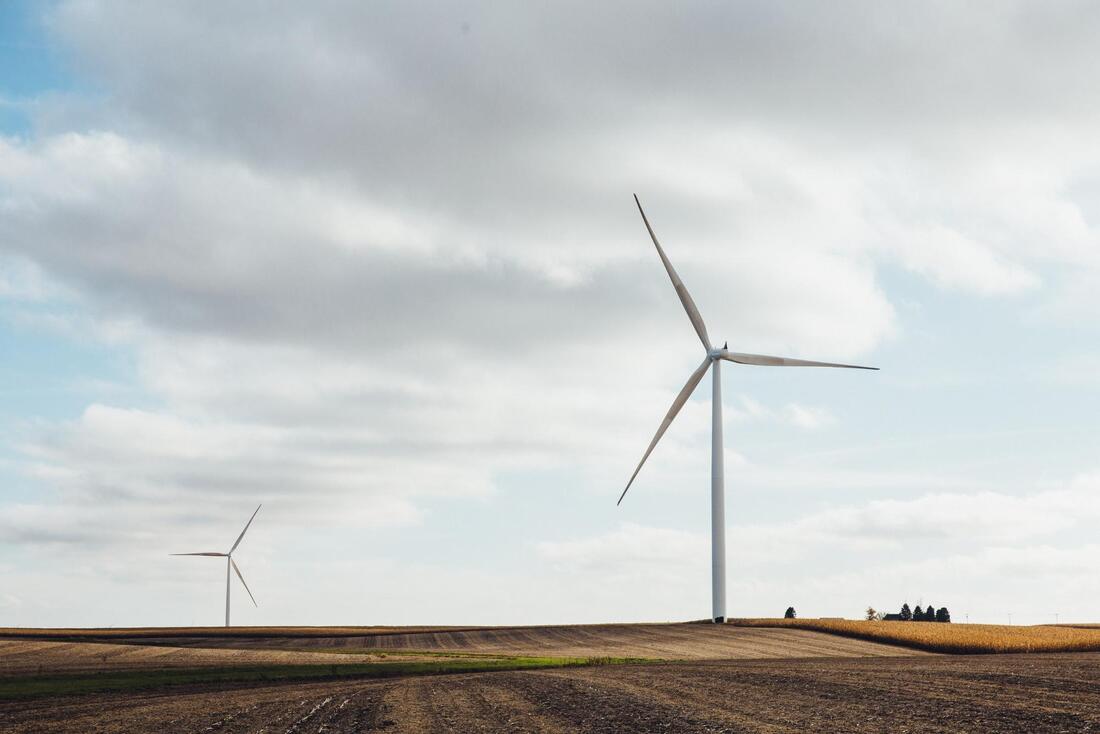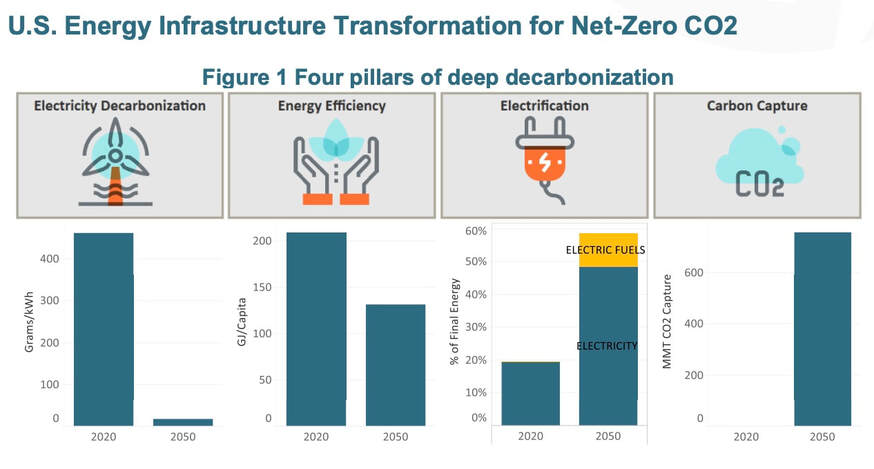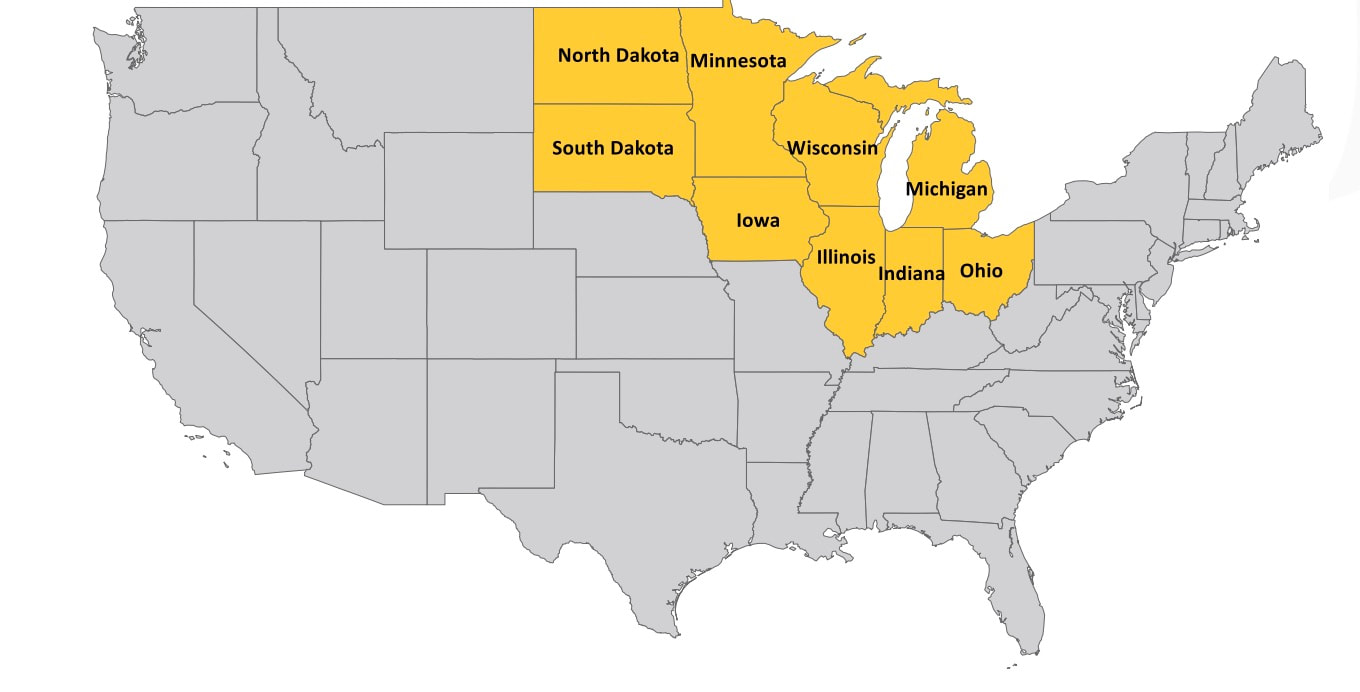This report explores unique opportunities and challenges for the Midwest region in the broader context of the transformative changes to the U.S. energy system that are required to reduce carbon dioxide (CO2) emissions to net-zero emissions in 2050. The scale and rate of physical changes to the U.S. energy system will be significant, and the Midwest will play a critical role in enabling a national transition. The implications of these changes to the region will be far-reaching, offering opportunities to grow new industries and jobs, as well as the chance to deploy climate mitigation and adaption policies that focus on ensuring an equitable energy transition. There are two central questions about the Midwest region in this report: how does the physical energy infrastructure in the Midwest region need to evolve to enable a low carbon transition, and what are key decarbonization opportunities and challenges in the Midwest? Answers to these questions can support regional stakeholders’ efforts to develop a shared vision of pathways to deep decarbonization, and advance discussions in states across the region. This study explores these questions over three sections: the first section provides context about the national pathways to deep decarbonization, which provides the basis for a Midwest regional exploration; the second section lays out the regional analysis approach and provides in-depth exploration of Midwest-specific topics; the final section considers broader implications of the physical changes for policymakers and long-term planners within the region.
|
National Context
Deep decarbonization of the U.S. economy will entail large scale infrastructure changes across multiple sectors. To understand the scope of these changes, it is critical to understand how both demand for, and supply of energy may evolve to support a low-carbon future. This study builds on previous national analysis of decarbonization, including deep decarbonization studies that examined the requirements for reducing greenhouse gas (GHG) emissions by 80% below 1990 levels by 2050 (“80 x 50”), as well as a recent study examining the changes necessary to stabilize the atmospheric concentration CO2-equivalent at 350 ppm by 2100. These previous studies found that achieving mid-century GHG reduction targets is technically feasible, economically affordable, and attainable using alternative technologies. The primary requirements of a transition to net-zero CO2 emissions by 2050 are the construction of energy infrastructure characterized by high energy efficiency, low-carbon electricity, replacement of fossil fuel combustion with decarbonized electricity and other low-carbon fuels, and carbon capture, along with the policies needed to achieve this transformation. |
Based on this analysis, and the previous decarbonization studies cited above, there are critical milestones along the pathway to deep national decarbonization. These key actions by decade provide a policy outcome blueprint for the physical transformation of the energy system. A blueprint will be essential because of the long lifetimes of infrastructure in the energy system and the carbon consequences of investment decisions made today. Additional blueprints are needed to support climate adaptation, which is not explicitly addressed here, and significant study is also needed around equity to ensure any energy system transition does not adversely impact disadvantaged communities or augment existing inequities.
2020’s
2020’s
- Large-scale electrification of transportation and buildings needs to begin in earnest to enable the very high electrification by the 2040s.
- Switch electricity system dispatch away from coal and to natural gas while the deployment of new renewable generation and transmission-system reinforcements both continue to accelerate.
- Electricity markets begin significant reforms to prepare for major changes load, from electrification and load flexibility, as well as a resource mix dominated by renewables.
- End new investments in infrastructure to transport fossil fuels (e.g., pipelines).
- Launch pilot projects for new technologies that will need to be deployed at scale after 2030, such as carbon capture for large industrial facilities.
2030’s
- Achieve maximum rates of renewable generation build-out, which will need to be sustained in the following decades.
- Effect significant build-out of electrical energy storage as storage prices continue to fall, and the volume of renewable energy increases.
- Attain levels of near 100% of new sale shares for key electrified technologies (e.g., light-duty electric vehicles).
- Begin large-scale production biofuels from advanced processes.
- Deploy large scale carbon capture on industrial facilities.
2040’s
- Achieve near-complete electrification of key end-uses, like light-duty vehicles and heating services in buildings, replacing direct fuel combustion with clean electricity.
- Extend nuclear generation at the end of its plant lifetime or replace it with new lowand zero-carbon generation technologies.
- Fully deploy advanced biofuel production with carbon capture to decarbonize enduses where electrification is not a viable strategy.
- Deploy bioenergy with carbon capture and storage (BECCS) or direct air capture (DAC) to achieve net-zero greenhouse gas emissions.
The DDP achieves its emissions target through four principal strategies (“four pillars”) shown in Figure 1: (1) electricity decarbonization, the reduction in emissions intensity of electricity generation by roughly 95% below today’s level by 2050; (2) energy efficiency, the reduction in energy required to provide energy services such as heating and transportation, by about 40% below today’s level; (3) electrification, converting end-uses like transportation and heating from fossils fuels to low-carbon electricity, so that electricity triples its share from just under 20% of current end uses to nearly 60% in 2050; and (4) carbon capture, the capture of CO2 that would otherwise be emitted from power plants, industrial facilities, and fuel production, along with direct air capture, rising from nearly zero today more than 700 million metric tons in 2050. The captured carbon may be stored or utilized for the production of synthetic renewable fuels.
Achieving this transformation by mid-century requires an aggressive deployment of low-carbon technologies. The scale of the infrastructure buildout for the U.S. and key actions between 2020 and 2050 include:
- Electrifying virtually all passenger vehicles and natural gas use in buildings.
- Increasing electricity generation capacity by more than seven-fold, primarily with low-cost solar and wind power, which grows by more than 10x, to meet greater load from electrified end-uses.
- New types of energy infrastructure will be created to work in tandem with a high-renewables electricity system to enable net-zero emissions. Namely large-scale industrial facilities for carbon capture and storage, the production of biofuels with negative net-lifecycle CO2, hydrogen production from electrolysis using excess renewable electricity and from biomass, as well as synthetic fuel production which utilizes hydrogen and captured carbon.
Let's Take a Regional Look
While the underlying analysis for this report is for the U.S. as a whole, there are significant regional variations in energy demand and supply that provide valuable insights to the Midwest. A regional study offers details on how the actions required for deep decarbonization align with regional geographical boundaries, and the unique opportunities for a given region in contrast to the rest of the country. These insights can illuminate key considerations for a collection of states that are likely to share similar resource potential, act as a common market for key technologies, and already coordinate on large-scale energy infrastructure (e.g., electric transmission).
Regions typically share comparable renewable energy resource potential, biomass production capability, and have tightly coupled electrical systems which depend on some level of regional coordination for long-term planning. They also represent a common market for critical consumer technologies such as electric heat pumps and electric vehicles. For example, the states in the Midwest have comparable heating and cooling requirements that high-performance heat pumps will need to meet, in effect acting as a common market for advanced heat pumps that perform well in cold climates. These commonalities for states within a region makes a regional-level analysis a valuable exercise for exploring transition in a more granular fashion the whole U.S., and also enables a discussion about critical long-term planning and policy questions that are a unique concern for the region.
While the underlying analysis for this report is for the U.S. as a whole, there are significant regional variations in energy demand and supply that provide valuable insights to the Midwest. A regional study offers details on how the actions required for deep decarbonization align with regional geographical boundaries, and the unique opportunities for a given region in contrast to the rest of the country. These insights can illuminate key considerations for a collection of states that are likely to share similar resource potential, act as a common market for key technologies, and already coordinate on large-scale energy infrastructure (e.g., electric transmission).
Regions typically share comparable renewable energy resource potential, biomass production capability, and have tightly coupled electrical systems which depend on some level of regional coordination for long-term planning. They also represent a common market for critical consumer technologies such as electric heat pumps and electric vehicles. For example, the states in the Midwest have comparable heating and cooling requirements that high-performance heat pumps will need to meet, in effect acting as a common market for advanced heat pumps that perform well in cold climates. These commonalities for states within a region makes a regional-level analysis a valuable exercise for exploring transition in a more granular fashion the whole U.S., and also enables a discussion about critical long-term planning and policy questions that are a unique concern for the region.
Scope and Research Questions
The region studied in this analysis is the Midwest, which for this study consists of Illinois, Indiana, Iowa, Michigan, Minnesota, North Dakota, Ohio, South Dakota, and Wisconsin. These states make up 17% of the U.S. population and 21% of U.S. energy-related emissions. In the past, the region has generally received limited attention around long-term planning for decarbonization relative to other regions of the U.S., such as the West Coast and the Northeast.
The region studied in this analysis is the Midwest, which for this study consists of Illinois, Indiana, Iowa, Michigan, Minnesota, North Dakota, Ohio, South Dakota, and Wisconsin. These states make up 17% of the U.S. population and 21% of U.S. energy-related emissions. In the past, the region has generally received limited attention around long-term planning for decarbonization relative to other regions of the U.S., such as the West Coast and the Northeast.
|
This report seeks to address two central research questions for the Midwest region: (1) How do energy supply and demand, investment, and infrastructure in the Midwest region need to evolve to enable a low carbon transition?; and (2) What are key decarbonization opportunities and challenges in the Midwest, and how do they interact both within and outside the region?
Through these research questions, we hope that this study can advance on-going discussions in the Midwest around achieving deep decarbonization to support regional and state-level action. Insights from the above research questions can build on existing successful work by organizations within the Midwest to solidify a shared vision of the Midwest’s unique role in a national effort to reach 2050 emission reduction targets. |
Efforts like the Principles of Equitable Policy Design for Energy Storage, which was developed in collaboration with numerous Midwest advocates, and the Minnesota Public Utility Commission's recent decision to update the cost of carbon for long term planning are representative of how decarbonization work is advancing in the region. Additional analysis from this study can support more integrated long-term planned and continued success in developing implementation plans. The national results presented in the previous section give context and set the stage for exploring key considerations for the Midwest as a region in a broader transition to a decarbonized economy.
Critical Topics within the Midwest: Opportunities & Central Questions
While this analysis shows the Midwest following a similar high-level decarbonization pathway as the entire U.S., the region plays a unique role in some facets of the transition and faces distinct challenges as compared to the rest of the country. From natural resource endowment across Midwestern states to unique regional considerations for an equitable transition, the Midwest will see significant opportunities but also face important policy and planning decisions on a pathway to deep decarbonization. The following sections explore key decarbonization topics for the Midwest in greater detail:
While this analysis shows the Midwest following a similar high-level decarbonization pathway as the entire U.S., the region plays a unique role in some facets of the transition and faces distinct challenges as compared to the rest of the country. From natural resource endowment across Midwestern states to unique regional considerations for an equitable transition, the Midwest will see significant opportunities but also face important policy and planning decisions on a pathway to deep decarbonization. The following sections explore key decarbonization topics for the Midwest in greater detail:
- New biofuels: The Midwest is likely to continue its role as a major producer of biofuels for national consumption, but there are questions about the continued dominance of corn ethanol driven by the electrification of light-duty vehicles.
- Carbon capture and storage: The region has about 15% of estimated national geological carbon storage capacity, and biomass production and fossil electric generation create opportunities for carbon capture in the Midwest.
- Light-duty auto transition: With numerous manufacturing facilities that support the automotive industry inside the region, the Midwest is uniquely positioned to be a leader in the massive electrification effort for cars and trucks.
- Electrification of building heating: The Midwest has higher heating demands than much of the rest of the country and will require high-performance heating electrification technologies or must instead use decarbonized gas for building heating at an anticipated cost premium.
- Exporting from the wind belt: The Midwest is home to some of the best onshore wind resource potential in the country, and the region could act as a major exporter of wind energy.
- Coal transition: More than 25% of current U.S. coal generation capacity is within the nine states analyzed. Under a deep decarbonization effort, the nearly 60 GW of coal in the Midwest will be retired, but what resources will replace it, and how quickly can this happen?
- The future of nuclear: There is a significant existing nuclear fleet in the Midwest, over 20% of all nuclear capacity in the U.S. Relicensing could be a low-cost means of continuing to provide decarbonized electricity however there is uncertainty around this possibility.
Study Implications
Deep decarbonization in the Midwest will present significant opportunities for economic growth and new jobs for the region, as well as the possibility of defining and executing a plan for an equitable transition to a net-zero CO2 emissions economy. The region could become a global leader in wind energy and power other regions with wind exports, lead the massive transformation of the light-duty auto fleet from gasoline to electricity and play a critical role in shaping a new industry that produces negative-emissions biofuels. But realizing these opportunities will require a shared, coherent long-term vision for the region, along with effective planning and well-crafted policy to address key questions along the pathway to deep decarbonization and execute in the near- and mid-term.
Achieving these desirable outcomes on the way to a net-zero emissions target in 2050 requires action today. This analysis highlights two critical implications for near- and mid-term actions in the Midwest to advance deep decarbonization: (1) long-term planning and cross coordination between sectors and geographies is essential, and builds toward a shared vision of the desired pathway to 2050; and (2) maintaining a focus on long-term goals is critical for when establishing near-term policy to advance decarbonization. Positioning the region and the nation to address the key questions raised in the previous sections successfully necessitates effective engagement with stakeholders to be able to act on the above implications. The focus of this analysis is the physical transformation of the energy system and challenges to enabling these changes, but its findings can support the local and state-level decision making that will be essential for designing an equitable transition and producing durable outcomes that can sustain decarbonization efforts for the next 30 years and beyond.
Deep decarbonization in the Midwest will present significant opportunities for economic growth and new jobs for the region, as well as the possibility of defining and executing a plan for an equitable transition to a net-zero CO2 emissions economy. The region could become a global leader in wind energy and power other regions with wind exports, lead the massive transformation of the light-duty auto fleet from gasoline to electricity and play a critical role in shaping a new industry that produces negative-emissions biofuels. But realizing these opportunities will require a shared, coherent long-term vision for the region, along with effective planning and well-crafted policy to address key questions along the pathway to deep decarbonization and execute in the near- and mid-term.
Achieving these desirable outcomes on the way to a net-zero emissions target in 2050 requires action today. This analysis highlights two critical implications for near- and mid-term actions in the Midwest to advance deep decarbonization: (1) long-term planning and cross coordination between sectors and geographies is essential, and builds toward a shared vision of the desired pathway to 2050; and (2) maintaining a focus on long-term goals is critical for when establishing near-term policy to advance decarbonization. Positioning the region and the nation to address the key questions raised in the previous sections successfully necessitates effective engagement with stakeholders to be able to act on the above implications. The focus of this analysis is the physical transformation of the energy system and challenges to enabling these changes, but its findings can support the local and state-level decision making that will be essential for designing an equitable transition and producing durable outcomes that can sustain decarbonization efforts for the next 30 years and beyond.
Excerpt reprinted with permission. Read the full report.






